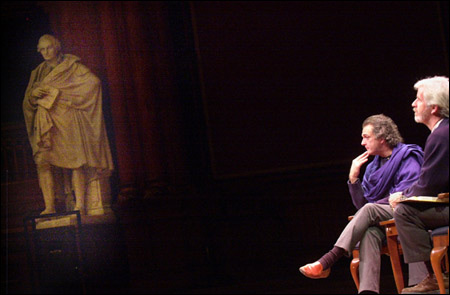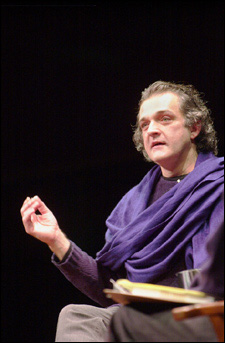The Morris Dance:
America’s foremost choreographer proves he’s still light on his feet

Dancer/choreographer Mark Morris spoke about his life and career Monday (March 10) as part of the Office for the Arts’ Learning From Performers program.
One thing the large Sanders Theatre audience certainly learned from Morris’ spontaneous, often hilarious remarks was that one can be a serious artist, yet not take oneself very seriously.
Born in Seattle in 1956, Morris founded his own dance company at the age of 24. In 1988 the group was offered the position of national Dance Company of Belgium. With Mikhail Baryshnikov, he founded the White Oak Dance Project in 1990. In 1991, he received a MacArthur Foundation “genius” award. Morris’ company recently established a dance center across the street from the Brooklyn Academy of Music and is the only single-choreographer dance company to own and operate its own center.
Questioned by former public radio talk show host Christopher Lydon, who moderated the event, Morris spoke about his attraction to dance as a young child and the dances he made up to pieces such as Tchaikovsky’s “1812 Overture” and “Danse Macabre” by Saint Saëns.
It’s ghost music,” he said of the Saint Saëns piece. “Skeleton music, haunted house music. It’s just scary, beautiful music – it’s fabulous, like a cartoon score.”

As a youngster in Seattle, Morris soaked up many musical influences, both from his family and from the ethnically diverse community in which he lived.
“The high school I went to had a fabulous African drumming ensemble that was headed by a teacher from what was still called Rhodesia – that shows how old I am. There was a Samoan musical group. I had lots of Japanese friends and I used to dance looking ridiculous with a fan and a hapi coat. There was a large African-American community. I had a fabulous friend, a woman who dated my sister. She was a transsexual, female to male. She ended up as the only white baritone in the African Methodist Episcopal Church.”
One of the first dance companies Morris belonged to was the Koleda Balkan Dance Ensemble, a semiprofessional group devoted to folk dancing. The experience had an important influence on his future artistic development.
“It was a whole subculture of nuts who did what was then called international folk dancing. They were marginal types like the chess club or the audiovisual squad. There were some mismatched socks and some Scotch tape on glasses. It was just a wonderful community of people who were friendly and welcoming and odd. That’s how I learned to hold hands and dance with other people and not stick out and not show I was intellectually independent of rhythm.”
Another early influence was the flamenco dancer José Greco.
“I had the great good fortune to take a workshop with him when I was 11, and I made up my mind then and there that I wanted to be a flamenco dancer. Then I went to study in Madrid and I decided that wasn’t the way to go. I think Francisco Franco had something to do with it. I was just coming out as a queer, and if you were a fag in Spain, you were essentially executed.”
After coming to New York, Morris danced with a number of companies including the Eliot Feld Ballet, the Hannah Kahn Dance Company, and the Lar Lubovitch Dance Company. All the while, he was making up dances of his own, and in 1980 he decided to put on a concert of his original pieces
“Lars Lubovitch said to me, ‘You’re not going to start a dance company, are you.’ I guess he was thinking that it’s very hard, and it is hard. You’re doing so many things and working with all these personalities, several of them your own. I really just wanted to make up dances and it never occurred to me that you needed a company to do that. I just asked my friends, who were all eager to do it because they were all working in restaurants.”
The Office for the Arts’ Learning From Performers program is sponsoring a clinic and open rehearsal with Roswell Rudd and Charlie Kohlhase on collective improvisation with the Harvard University Jazz Band on April 10 at 7:30 p.m. in the Reid Tonkens Room, Winthrop House, 32 Mill St. The event is free and open to the public. For more information, call (617) 495-8676.
Later in the program, Lydon invited members of the audience to ask questions. One audience member asked Morris about the creative process and how he goes about creating dances. He replied that there was no great mystery to it.
“People ask about the creative process, what’s the secret? There isn’t one. I’m never suddenly struck with ideas; it’s never an epiphany. Not that I’m even-keeled and never get excited – I do. But ultimately, it’s just a show, just a dance – it’s not going to hurt anyone.”
Morris said that in creating a dance he always starts with the music and that suggests dance movements to him. Asked what other ways there were to choreograph a piece, he said:
“There was a modern-postmodern period when one declared one’s independence from the tyranny of music. I get criticism to this day that my dances are predictable and tied to the beat. What else are they supposed to be tied to?”
Asked about the relation between art and politics, Morris said:
“In my own experience, I’ve found that the better something works as a piece of politics, the less likely it will succeed as a work of art. I don’t feel it’s my mission to convince people through my art to think like I do. I used to be more loud-mouthed about being queer, but I don’t do that any more. I have personal opinions and beliefs, and of course it’s built into my work, but I don’t try to change anyone.”
Asked whether he might ever go into academia, Morris replied in the negative.
“I’ve written recommendations for friends who want a job in, I don’t know, Whatsamatter U, but I never went to college a single day. I taught in a college once, and I learned there was a course called “Methodologies of Dance,” and I thought, “Hmm … no!” I’m exactly the wrong sort of person for that. It’s ironic because now I have three honorary doctorates. I’m like a triple doctor.”
Asked whether having his own dance center made him feel more established, Morris revealed the accomplishments he really regards as marks of success.
“I was asked to appear on ‘Sesame Street,’ and I thought, wow, now I’ve really made it. And then I got invited to a cocktail party for Marcel Marceau’s 80th birthday. Isn’t that fabulous? That and once touching Sophia Loren’s fur coat.”




